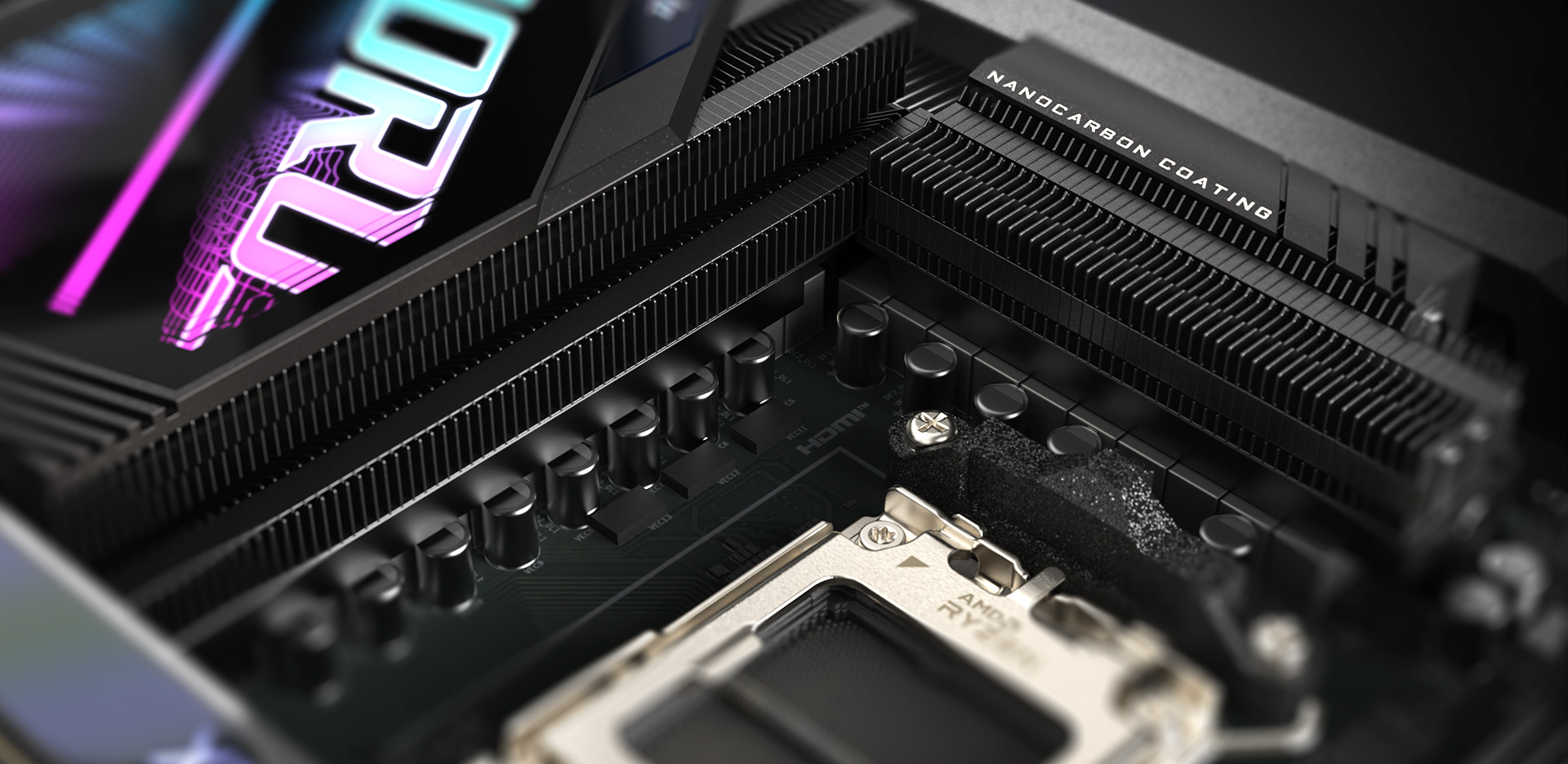Enthusiasts report Gigabyte X870E Aorus Xtreme chipset temps exceeding 100°C
Poor heatsink contact suspected to be the culprit.

Gigabyte's X870E Aorus Extreme AI TOP motherboard is suffering from high chipset temperatures, as suggested by several reports on Reddit. Chipset temperatures north of 100 degrees Celsius led a user to disassemble the motherboard, revealing poor heatsink contact on one of the two daisy-chained Promontory 21 chipsets. Now, if this does end up being a slight misalignment in the assembly phase, only a handful of units should be affected. However, a more deeply rooted issue might be more challenging to address, but let's not get ahead of ourselves.
AMD's design for the X870E links two Promontory 21 chipsets in a daisy-chained arrangement, as was the case with the X670E. Flagship 800-series and 600-series motherboards thus reveal two Promontory 21 chipsets upon removing the heatsink. Functionally, both of these chipsets are similar, though they have varying arrangements. Hardware monitoring utilities like HWiNFO thus report two different temperature readings under the chipset section.
User u/Xabiro shared a HWinFO screenshot showing their Gigabyte X870E Aorus Xtreme's second-chipset at nearly 110 degrees Celsius. Coupled with the Ryzen 9 9950X3D, the system doesn't appear to be under much load. Jumping to the comment section, another user confirmed similar problems with their unit. u/Xabiro removed the heatsink covering both chipsets to determine the underlying problem.
It quickly becomes clear that one of the chipsets isn't making any contact with the heatsink. The thermal paste applied from the factory on the right contact surface shows no deformation or contact like it was never pressed against the chipset, which also appears dry as bone. The user applied more thermal paste to eliminate any clearance between the two surfaces. This lowered the temperatures to a moderate 71 degrees Celsius. Applying a thermal pad in tandem with the thermal grease further dropped the temperatures to 64 degrees Celsius.
Ironically enough, just days after criticizing Asus' GPU quick-release implementation, a theory proposes that Gigabyte's own release lever design might be at fault here. As this lever sits below the heatsink, potentially causing slight vertical elevation, it is believed to disturb contact between the chipset and the heatsink, leading to the high temperatures we see.
Consumers expect rigorous testing and validation when paying top money for a premium top-of-the-line motherboard. However, based on the limited data and number of reports, we shouldn't jump to premature conclusions. Still, another unfortunate customer reported a similar issue with their model, so this likely isn't a one-off case.
Get Tom's Hardware's best news and in-depth reviews, straight to your inbox.

Hassam Nasir is a die-hard hardware enthusiast with years of experience as a tech editor and writer, focusing on detailed CPU comparisons and general hardware news. When he’s not working, you’ll find him bending tubes for his ever-evolving custom water-loop gaming rig or benchmarking the latest CPUs and GPUs just for fun.
-
HardwiredWireless Oh no, a mass produced product with some assembly flaws on the first run? It's the end of the world!Reply -
pclaughton Reply
Right, because it's not like the article explains why this is the wrong mindset.HardwiredWireless said:Oh no, a mass produced product with some assembly flaws on the first run? It's the end of the world!
Consumers expect rigorous testing and validation when paying top money for a premium top-of-the-line motherboard.
Oh, wait... -
LabRat 891 Just Gigabyte things.... :rolleyes:Reply
They have had on-going 'systemic' issues, as indicated by these kinds of blatant oversights.
-My GB 7900 GRE arrived sealed new in box w/ missing and loose screws.
-GB PSUs were firecrackers for awhile
-My Friend's GB B650 is easily the most 'finnicky' and 'inconsistent' (factory firmware) motherboard I've ever worked with.
-GB's entry-level motherboards have had on/off history of VRM self-immolation
-In my experience, GB is very RMA denial happy. (Though, that's been supplanted by Asus' shenanigans, in recent times.)
I'm seriously waiting for the North American market to wakeTFup to GB and the rest of The Industry's extremely lacking quality standards. -
The Historical Fidelity Reply
Too true, I stopped buying Gigabyte in the early 2000’s when the first mobo I purchased with my hard earned money, during the athlon xp era, kept on frying the bios chip. I had it RMA’ed 4 times, the first 3 were full mobo replacements, then the 4th, Gigabyte gave up and sent me 10 raw bios chips (back when the bios chip was press fit into its unique socket somewhere on the mobo) and that lasted me a couple years until I moved on to athlon 64 cpu series.LabRat 891 said:Just Gigabyte things.... :rolleyes:
They have had on-going 'systemic' issues, as indicated by these kinds of blatant oversights.
-My GB 7900 GRE arrived sealed new in box w/ missing and loose screws.
-GB PSUs were firecrackers for awhile
-My Friend's GB B650 is easily the most 'finnicky' and 'inconsistent' (factory firmware) motherboard I've ever worked with.
-GB's entry-level motherboards have had on/off history of VRM self-immolation
-In my experience, GB is very RMA denial happy. (Though, that's been supplanted by Asus' shenanigans, in recent times.)
I'm seriously waiting for the North American market to wakeTFup to GB and the rest of The Industry's extremely lacking quality standards.
Turns out that particular mobo model had faulty pcb wiring that would produce random transient voltage spikes that jumped into an adjacent bios chip signal wire.
Honestly, I give Gigabyte props for sending me 3 additional motherboards (I actually still have them in my closet lol) and them sending me 10 bios chips was more helpful than replacing the mobo altogether, so can’t really talk bad about their RMA policy at the time, but I can talk bad about their decision to keep selling the mobo and eating the RMA cost instead of revising the PCB layout. I don’t support companies that knowingly sell faulty products. -
jp7189 Reply
I've had 3 recent Aorus Master series MBs (x670e, z690, x870e), and they have been really solid. My only complaint is i felt like RAM on the x670e should have overclocked better.LabRat 891 said:Just Gigabyte things.... :rolleyes:
They have had on-going 'systemic' issues, as indicated by these kinds of blatant oversights.
-My GB 7900 GRE arrived sealed new in box w/ missing and loose screws.
-GB PSUs were firecrackers for awhile
-My Friend's GB B650 is easily the most 'finnicky' and 'inconsistent' (factory firmware) motherboard I've ever worked with.
-GB's entry-level motherboards have had on/off history of VRM self-immolation
-In my experience, GB is very RMA denial happy. (Though, that's been supplanted by Asus' shenanigans, in recent times.)
I'm seriously waiting for the North American market to wakeTFup to GB and the rest of The Industry's extremely lacking quality standards. -
lowlifedog Generally I would give the manufacture the benefit of the and expect them to take care of early adopters and fix the problems on future production. However for an over $1000 board GET IT RIGHT before you release it...Reply